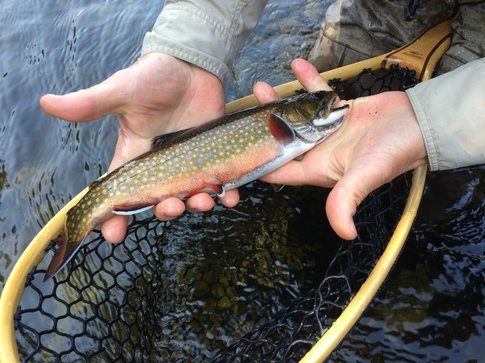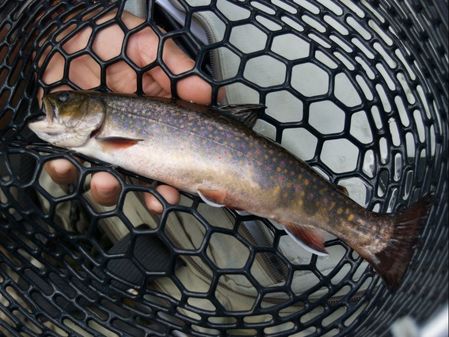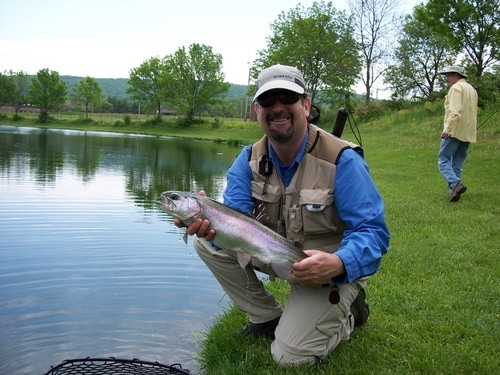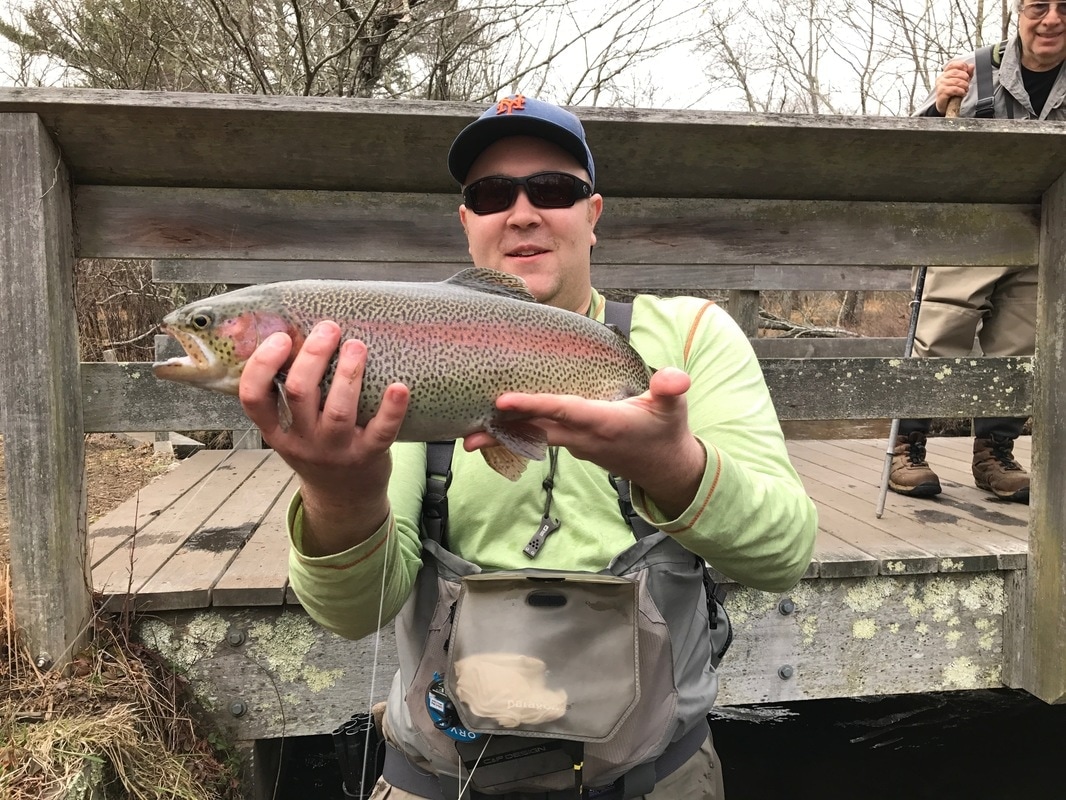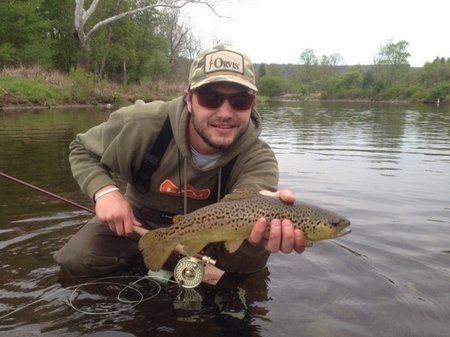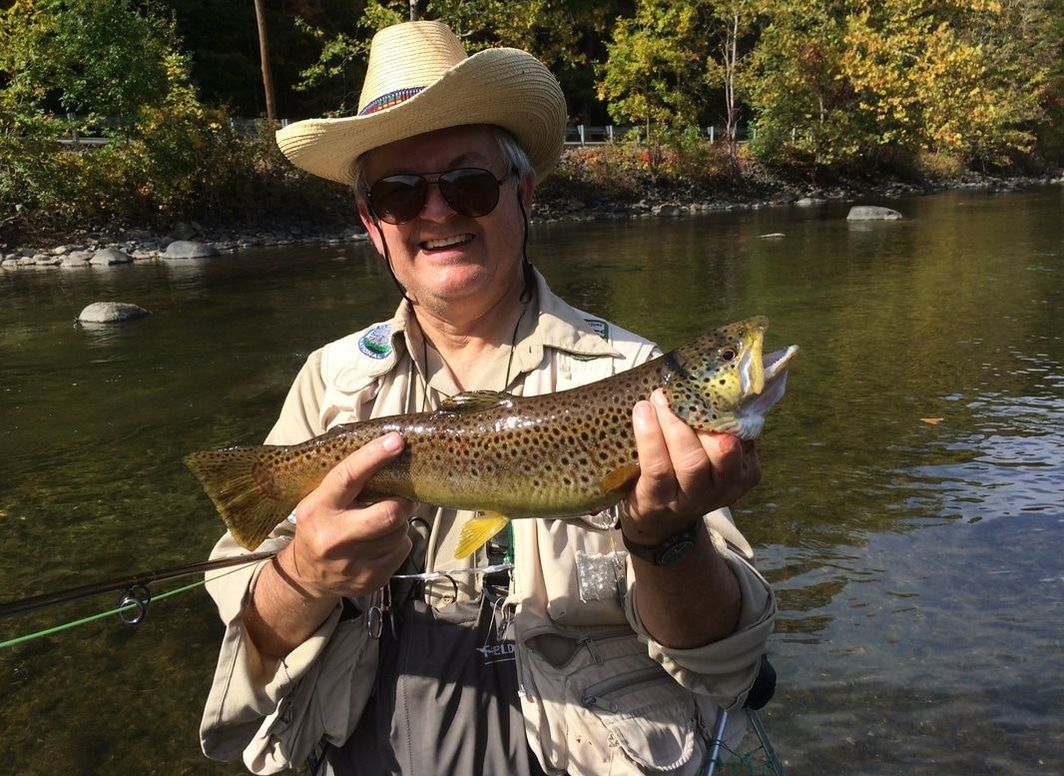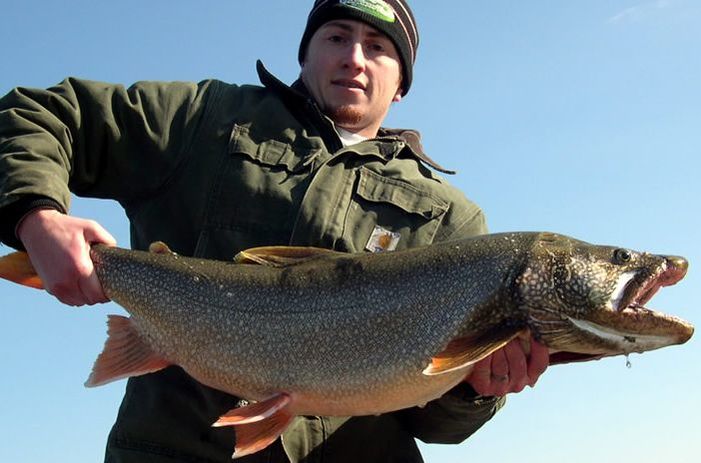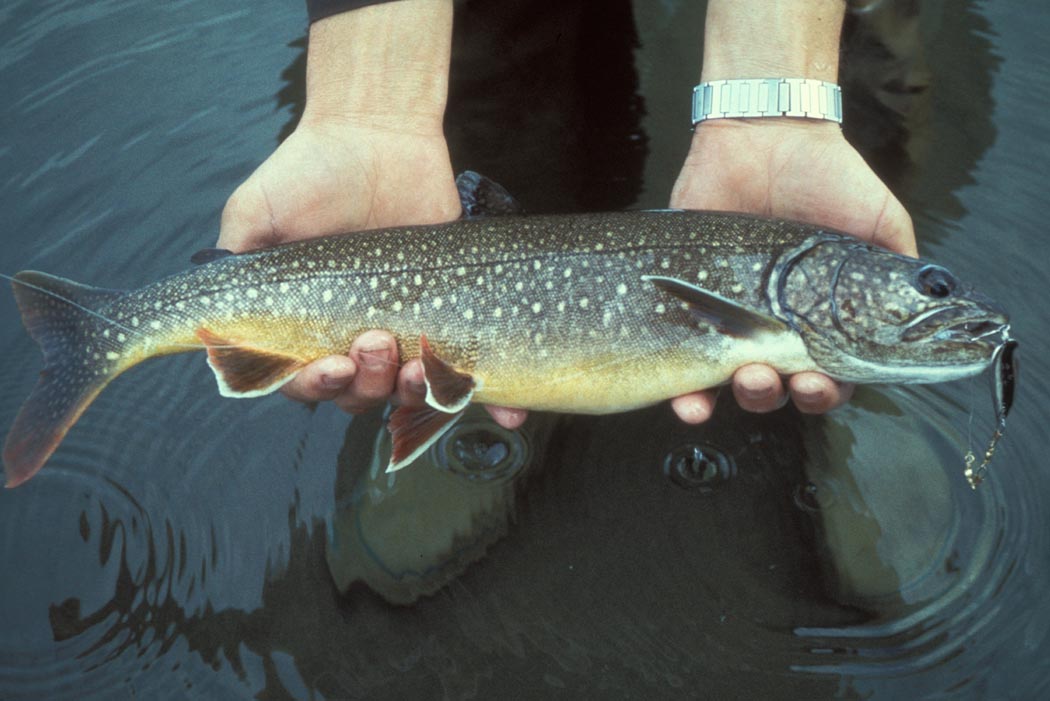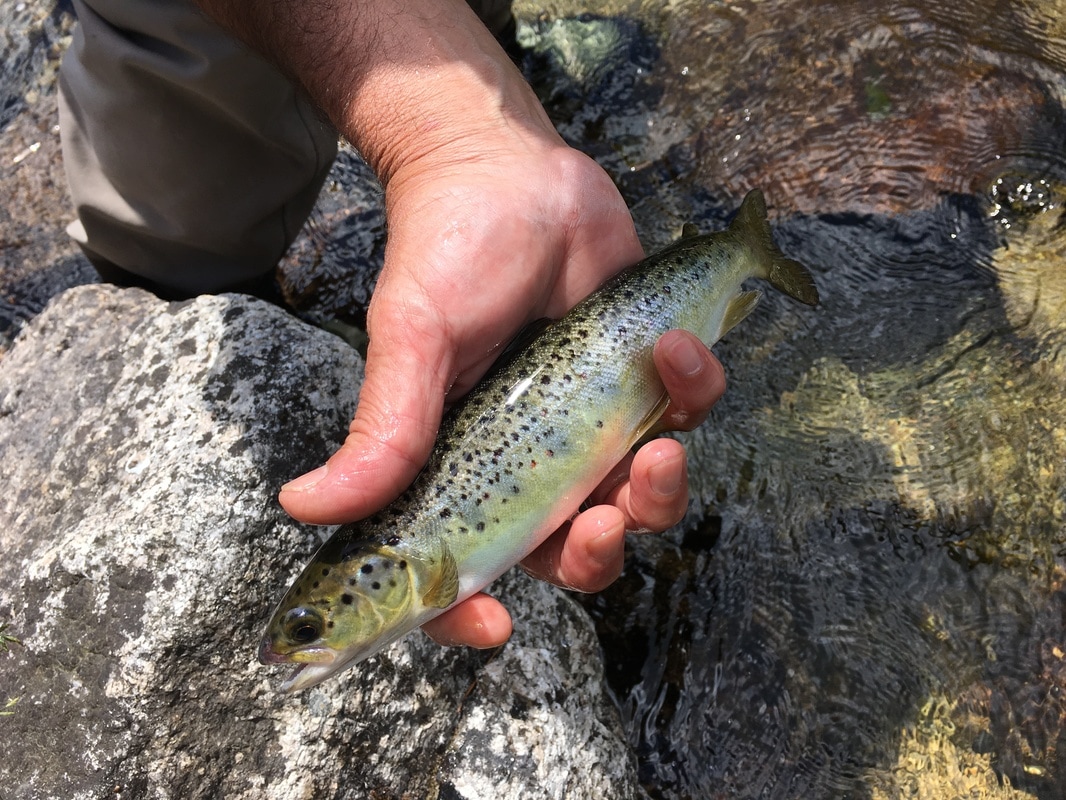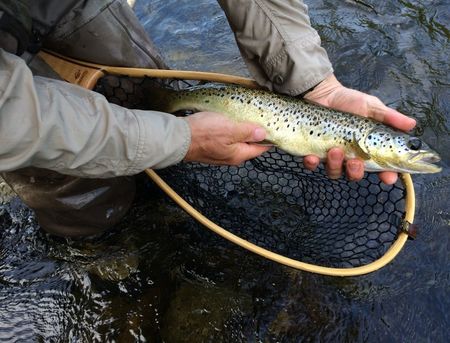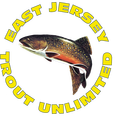Our New Jersey Salmonids
Overview: Salmonids or salmonidae are a family of predatory fish within the order of salmoniformes that have rayed fins. This family includes trout, salmon, chars, graylings and freshwater whitefishes. All salmonids spawn in freshwater, although several species are anadromous can spend much of their lives at sea such as the atlantic salmon, the pacific salmon species and steelhead.
Acantholingua, brachymystax, coregonus, hucho, oncorhynchus, prosopium, salmo, salvelinus, salvethymus, stenodus and thymallus are genus that are members of the salmonid family.
Salvelinus (chars), Salmo (trout and atlantic salmon) and Onchorhynchus (rainbow trout and pacific salmon species) are the genus of salmonids traditionally of particular interest to fly-fishermen. Species of Salvelinus, Salmo and Onchorhynchus can be fly-fished for throughout the state of New Jersey. Basic information regarding the specific species currently present in the State of New Jersey follow.
Overview: Salmonids or salmonidae are a family of predatory fish within the order of salmoniformes that have rayed fins. This family includes trout, salmon, chars, graylings and freshwater whitefishes. All salmonids spawn in freshwater, although several species are anadromous can spend much of their lives at sea such as the atlantic salmon, the pacific salmon species and steelhead.
Acantholingua, brachymystax, coregonus, hucho, oncorhynchus, prosopium, salmo, salvelinus, salvethymus, stenodus and thymallus are genus that are members of the salmonid family.
Salvelinus (chars), Salmo (trout and atlantic salmon) and Onchorhynchus (rainbow trout and pacific salmon species) are the genus of salmonids traditionally of particular interest to fly-fishermen. Species of Salvelinus, Salmo and Onchorhynchus can be fly-fished for throughout the state of New Jersey. Basic information regarding the specific species currently present in the State of New Jersey follow.
Brook Trout (Salvelinus Fontinalis) - "Brookie" or "Speckled Trout" or "Squaretail"
Species Notes: Brook trout is New Jersey's only native Salmonid and is our official state fish. It is not currently stocked by the State, therefore any brookies caught in New Jersey should be presumed to be wild. Brook trout are fall spawners. Although referred to as "trout" our brookies are actually classified as a char within the genus of Salvelinus. Most brook trout in New Jersey today can be found in small streams. Sea-run brook trout are called "Salters". Brook trout are very sensitive to water quality and temperature. In New Jersey salvelinus fontinalis has been extirpated from much their original habitat and have been replaced with salmonids that are not native to the state, such as rainbow trout and brown trout. "Fontinalis" is translated to english as a fountain or spring. New Jersey has about 120 streams with brook trout that reproduce in the wild.
Brook trout can be easily identified by the green and yellow worm-like markings on their back referred to as vermiculation. Brookies have red or pink spots with surrounding blue halos. Brook trout fins are orange with black and white striped edges. They are true beauties.
Species Notes: Brook trout is New Jersey's only native Salmonid and is our official state fish. It is not currently stocked by the State, therefore any brookies caught in New Jersey should be presumed to be wild. Brook trout are fall spawners. Although referred to as "trout" our brookies are actually classified as a char within the genus of Salvelinus. Most brook trout in New Jersey today can be found in small streams. Sea-run brook trout are called "Salters". Brook trout are very sensitive to water quality and temperature. In New Jersey salvelinus fontinalis has been extirpated from much their original habitat and have been replaced with salmonids that are not native to the state, such as rainbow trout and brown trout. "Fontinalis" is translated to english as a fountain or spring. New Jersey has about 120 streams with brook trout that reproduce in the wild.
Brook trout can be easily identified by the green and yellow worm-like markings on their back referred to as vermiculation. Brookies have red or pink spots with surrounding blue halos. Brook trout fins are orange with black and white striped edges. They are true beauties.
Rainbow Trout (Oncorhynchus Mykiss) - "Bow"
Species Notes: Rainbow trout are native to the pacific watershed and are not native to New Jersey. Although referred to as a "trout", rainbow trout are actually classified as a member of the genus Oncorhynchus, which includes their fellow pacific salmonid species of king, silver, pink, dog and sockeye salmon. Sea run rainbow trout are called steelhead. Rainbows spawn in the spring time. Rainbow trout are the only trout currently stocked by the State of New Jersey due to their hardiness and disease resistance. They are raised at the Pequest Hatchery. "Oncorhynchus" means hooked-jaw. The state of New Jersey has approximately 20 naturally reproducing populations of rainbow trout.
Rainbows can be identified by their silvery light colored bodies with dark black spots. This species has can be easily identified by the long pink slash present on each side of the fish and pink gill plates.
Brown Trout (Salmo Trutta) - "Brownie"
Species Notes: Brown trout are native to England and paces in northern Europe. It is an exotic species and in not native to North America. Salmo Trutta was introduced to the United States in the 1883. They are not currently stocked by the State of New Jersey and any fish caught should be presumed to be wild fish. Brown trout are spring spawners. "Trutta" is latin for trout and this species is a true trout classified within the genus of salmo. New Jersey has about 80 streams with populations of brown trout that reproduce in the wild.
Brown trout can be indentified by their red and black spots with white halos. Salmo trutta's bellies are usually a golden yellow color and they have dark brown backs. They are similar in appearance to and can often be confused with landlocked atlantic salmon.
Species Notes: Brown trout are native to England and paces in northern Europe. It is an exotic species and in not native to North America. Salmo Trutta was introduced to the United States in the 1883. They are not currently stocked by the State of New Jersey and any fish caught should be presumed to be wild fish. Brown trout are spring spawners. "Trutta" is latin for trout and this species is a true trout classified within the genus of salmo. New Jersey has about 80 streams with populations of brown trout that reproduce in the wild.
Brown trout can be indentified by their red and black spots with white halos. Salmo trutta's bellies are usually a golden yellow color and they have dark brown backs. They are similar in appearance to and can often be confused with landlocked atlantic salmon.
Lake Trout (Salvelinus Namaycush) - "Togue" or "Laker"
Species Notes: Lake trout, like brook trout are actually a char. They are most often found down deep in lakes and typically can be caught in the shallows of lakes and rivers on a fly during the spawning season only. Lakers are not native to New Jersey, but have been introduced to our lakes. Lakers spawn in the fall. Lake trout are native to Canada and the northern US.
Lake trout are similar in appearance to brook trout.
Species Notes: Lake trout, like brook trout are actually a char. They are most often found down deep in lakes and typically can be caught in the shallows of lakes and rivers on a fly during the spawning season only. Lakers are not native to New Jersey, but have been introduced to our lakes. Lakers spawn in the fall. Lake trout are native to Canada and the northern US.
Lake trout are similar in appearance to brook trout.
Landlocked Atlantic Salmon (Salmo Salar) - "Ouananiche"
Species Notes: Landlocked Salmon are the same species as sea-run atlantic salmon, except that they spend their entire life in freshwater lakes and rivers. They are closely related to brown trout and are native from Connecticut to Canada. They are currently stocked by the state in several New Jersey lakes such as Wawayanda, Aeroflex and Tilcon. They are known for the spectacular jumps they take after being hooked. "Salar" means jumper.
Species Notes: Landlocked Salmon are the same species as sea-run atlantic salmon, except that they spend their entire life in freshwater lakes and rivers. They are closely related to brown trout and are native from Connecticut to Canada. They are currently stocked by the state in several New Jersey lakes such as Wawayanda, Aeroflex and Tilcon. They are known for the spectacular jumps they take after being hooked. "Salar" means jumper.

